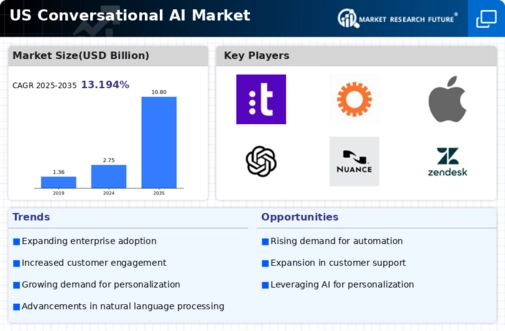Rising Demand for Automation
The increasing demand for automation across various sectors is driving the growth of the conversational ai market. Businesses are actively seeking solutions that can automate routine tasks, enhance operational efficiency, and reduce costs. For example, the implementation of conversational agents in customer support can lead to a reduction in operational costs by up to 25%, as these systems can handle multiple inquiries simultaneously without human intervention. This trend is particularly evident in industries such as retail and finance, where companies are investing heavily in automation technologies. As organizations recognize the potential of conversational ai to streamline processes and improve service delivery, the market is likely to experience substantial growth, with projections indicating a market size of over $20 billion by 2027.
Technological Advancements in AI
The rapid evolution of artificial intelligence technologies is a primary driver for the conversational ai market. Innovations in natural language processing (NLP) and machine learning algorithms enhance the capabilities of conversational agents, making them more efficient and user-friendly. As organizations increasingly adopt these technologies, the market is projected to grow significantly. For instance, the conversational ai market is expected to reach approximately $15 billion by 2026, reflecting a compound annual growth rate (CAGR) of around 30%. This growth is largely attributed to advancements that allow for more sophisticated interactions, enabling businesses to improve customer engagement and streamline operations. Consequently, the integration of cutting-edge AI technologies is likely to propel the conversational ai market forward, as companies seek to leverage these tools for competitive advantage.
Increased Investment in AI Startups
The surge in investment in AI startups is a critical driver for the conversational ai market. Venture capitalists and private equity firms are increasingly funding innovative companies that focus on developing advanced conversational ai solutions. This influx of capital is fostering innovation and accelerating the development of new technologies within the market. In 2025 alone, investments in AI startups have reached approximately $10 billion, indicating a robust interest in the potential of conversational ai. As these startups introduce novel applications and functionalities, they contribute to the overall growth of the market. The competitive landscape is likely to evolve, with new entrants challenging established players, thereby driving further advancements in the conversational ai market.
Integration with Emerging Technologies
The integration of conversational ai with emerging technologies such as the Internet of Things (IoT) and big data analytics is significantly influencing the conversational ai market. This convergence allows for more intelligent and context-aware interactions, enhancing the overall user experience. For instance, smart home devices equipped with conversational ai capabilities can provide users with seamless control over their environments, leading to increased adoption. Furthermore, businesses are leveraging big data to analyze customer interactions, enabling them to refine their conversational ai strategies. This trend is likely to propel the market forward, as organizations recognize the value of integrating these technologies to create more responsive and adaptive systems. The conversational ai market is anticipated to grow substantially, with estimates suggesting a market value exceeding $18 billion by 2028.
Shift Towards Enhanced Customer Experience
A notable driver for the conversational ai market is the shift towards enhancing customer experience. Companies are increasingly prioritizing customer satisfaction and engagement, recognizing that effective communication is crucial for retaining clients. Conversational ai solutions provide businesses with the tools to offer personalized interactions, thereby improving customer loyalty. Research indicates that organizations utilizing conversational agents report a 20% increase in customer satisfaction rates. This focus on customer experience is prompting businesses to invest in conversational ai technologies, as they seek to differentiate themselves in a competitive landscape. As a result, the conversational ai market is expected to expand, with a projected growth rate of 25% annually over the next few years, driven by the need for improved customer interactions.























Leave a Comment